My rule for conducting a case study is that it must be as close to a real-life example as possible and have the goal of making money. Experiments inside the case study, on the other hand, can be ongoing and don’t have to make money directly. And by definition, a case study is not an actual scientific experiment. We’re just testing a hypothesis to see if it has a meaningful impact on our key performance indicators.
The Hypothesis
This experiment is to create and get a completely new website indexed in Google (and other search engines) with a focus on organic traffic by doing genuine keyword research and writing epic shit.
The hypothesis is that this will still be possible in 2022 and 2023 to publish content online, get it to rank, and earn a (real, meaningful) income from it.
Publishing means:
- Selecting a profitable niche
- Doing authentic and repeatable keyword research
- Write (and outsource) awesome and helpful content
- …including photos, graphics and video
- Optimising titles and descriptions.
- Getting the content picked up by the search engines (really just Google)
- …and getting it to rank among the top 3 results
The Goals
There are multiple goals I’d like to achieve with this experiment.
- Learn (and report) on how to best get website content indexed and ranking in search results. And in this learn how best practices are performed on a website, and also what tasks are redundant, old-school ideas that don’t work anymore.
- Make money. The point is to get a business running and provide financial security for my kids and me. Also, of course, give us the opportunity for adventure and to explore the world. Well, maybe also to get a bit of recognition, to be honest – but mostly money.
- Create SOPs (Standard Operating Procedures) on the whole creation process so I can easily repeat with new sites and iterate making the creation flow more streamlined.
The measurable gaols are going to be:
- Reach a 17,500 $ (it’s a round number in my currency) sales evaluation estimated by 35 times monthly revenue.
- Monthly revenue most, therefore, reach 500 $
- With an EPMV (Earnings Per Thousand Visitors) of 12-15 $, this will require 42,000 to 33,000 monthly pageviews.
… the experiment will obviously be to increase both the EPMV and the sales price. For example, if I learn how to get an EMPV at 20 $ and can sell the site at a 42 times multiple of the monthly revenue, I’ll reach my goal faster (or maybe even exceed it).
If I choose the right niche and do proper keyword research this should be doable – but let’s see.
Follow along if you want to see me fail or succeed. Either way, I’m reporting on my results here, and on my YouTube channel…
Month 0: Choosing a website niche
At the end of the day choosing a niche for your website is going to be a gut decision. No matter how hard you try to be analytical, your feelings will eventually dictate your actions.
If you realize this, the chances of you making the best decision for you will increase – I feel.
To bring out some of the details that go into the decision process I use a “Weighted Average Matrix” I learned from Corbett Barr at Fizzle.
…and you might be able to guess what niche I choose.
Month 1: Revisiting the Keyword Golden Ratio
I spend the first month doing keyword research there are therefore not any results to report on …yet.
In the spirit of iterating on previous results, I went back to look at some of my older sites. I’ve been using the Keyword Golden Ratio on-and-off for a couple of years, so I went back and took a look at the results.
Going back and looking at results retrospectively is NOT best practice in science – I know. But it’s better than guesswork. I actually manage to pull out some interesting data …and this actually shows the opposite of what the Keyword Golden Ratio method was intended for.
This is not at the scientific standard I’d like to keep, though. I’m therefore going to set up a more rigorous and prospective study in the coming months.
Month 2: The hidden DANGER of aged domains
Most participating in this case study series are starting aged domains. They seem to be all the hype these days.
I’m starting on a fresh domain, and I have a very specific reason for doing so. I have multiple failed projects in my past scaring me off.
I’m not done with aged domains (I’m currently working on another project with one actually), but I definitely have to do it better next time.
What I failed to do was find and reestablish the niche the sites had authority in, effectively hindering my own progress.
Don’t do that!
Month 3: 60 articles at once (My Content Strategy)
I spend the month of March doing keyword research for the niche website. In true scientific fashion, I’m doing this as a prospective study. Hopefully, this will help both you and me learn something.
If you go back and look at old data to find some patterns you could easily land on something that seems directly correlated but in reality, has nothing to do with each other.
One of my favourite examples is article length. If you look at top-ranking articles on a website they will most likely be long (plus 2500 words). This could lead you to believe that just making an article longer will make it rank better.
In fact, people are actually doing this.
When in reality it’s making an article more in-depth and thorough, that makes it rank better. It just happens to make the text longer in the process.
To avoid this scientist’s design prospective studies, where they instead test their hypothesis. In this example it would be: “Just make the article longer, will make it rank better”. The scientist would then increase the word count and measure the result.
Do you think the scientist would find that his article ranks better?
In short, the difference between the two questions are:
- Retrospective: My top-ranking articles are always long = long articles always rank better
- Prospective hypothesis: Just increasing the word count will improve the ranking. Yes or no?
Can you see what test would yield the strongest and most believable result?
In this way, I’ve designed a prospective study by doing keyword research with 6 different methods. Even though some of the keywords are clearly giving hard-to-rank articles, I HAVE to create them – for science. This is what “prospective” requires.
The 6 methods are:
- Zero Volume Keywords
- Keyword Golden Ratio (KGR)
- Alphabet Soup
- Sleeper Keywords
- LowFruit Top 10 Keywords
- KeywordChef Selected Keywords
Month 4: I installed spam on my sites
This month I really have set myself back. I’ve installed spam on my sites.
I had a plan 6-8 months ago, and I was hard at work carrying it out. I was mostly working on two sites: One of my Danish authority sites and an English language niche site.
It seemed that none of them would move. Actually, one decreased in traffic, the other one increased slightly, but not in any meaningful way.
I became demotivated and then it happened: I found myself on Flippa looking at shiny objects, dreaming of a world where I could sell sites that earned a decent income. I even bid on a couple of them.
Then, at the beginning of the month (3 months later), I won the bidding, and I bought the site. I had moved on, but I could just revive the site, and set it aside for another rainy day …or so I thought.
Little did I know the backup file contained spam, and because I have some sites on shared hosting with BlueHost, it spread to all 8 sites on that server – including this Project Icarus Case Study niche website.
This is what Shiny Object Syndrome can do to you…
Month 5: 100 % indexed in one month
Finally, there are some results to report on, and all 62 articles are indexed.
| Month | Articles | Page Views | Earnings |
|---|---|---|---|
| January 2022 | 1 (100 % indexed) | 24 | 0 $ |
| February 2022 | 2 | 46 | 0 $ |
| March 2022 | 2 | 37 | 0 $ |
| April 2022 | 2 [+spam] | 247 | 0 $ |
| May 2022 | 62 (100 % indexed) | 155 | 0 $ |
It looks like the Case Study site is actually getting some real organic traffic now, that is not just me updating the site or random bot traffic.
I really looove the period where the blue line lets go of the baseline, consistently gets multiple visits a day (just more the one really), and takes off up into the far right.
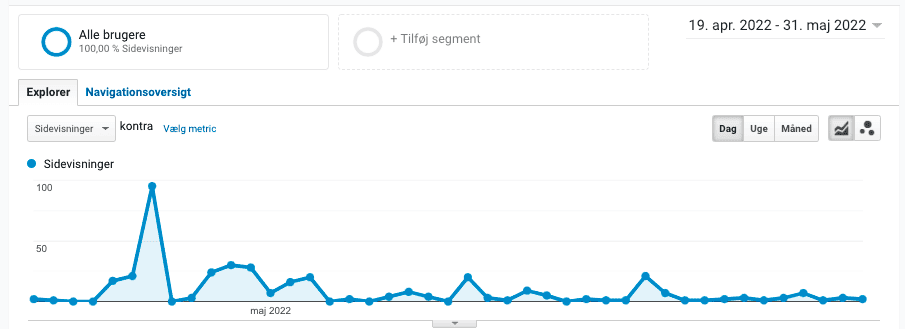
As proof, I’ve taken a screenshot from Google Search Console showing the valid URLs on the site. In reality, they didn’t all index on the same day. I guess the servers just decided to update the sitemap on that day. The scary hole just before is what the spam did to my website.
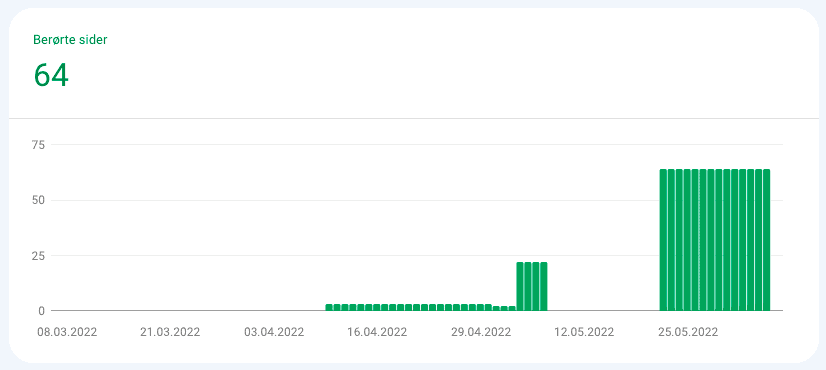
Month 6: Month of Monetization
This month I’m going to set up ads with Ezoic Access Now and hopefully earn the first bit of income. I didn’t quite make it to one full dollar, but now ads are set up and will be running.
I also reveal that I have about 250 pageviews now. That is actually very nice given that most articles are published in month 5 and also needed some time to get indexed.
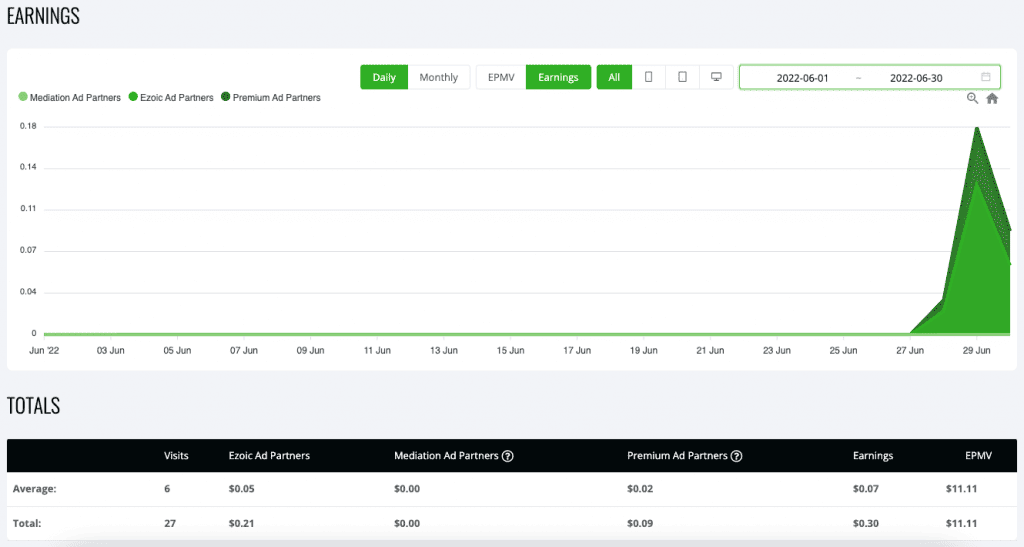
Month 7: Is passive income a real thing?
This month I worked extra hours in the vet’s clinic, and I had a 2-week vacation, so I didn’t do much with the case study. It is still growing and is still earning me money, so it is earning me passive income.
Not passive in the sense I don’t have to do any work to get to where I am, and not passive in the sense that I don’t have to do maintenance for the project to stay healthy.
But it’s passive enough for me to leave the site unattended for a full month and it still earns me a little money.
In this month’s update video, I propose to call it “perpetual income” instead as It describes what it actually is more precisely.
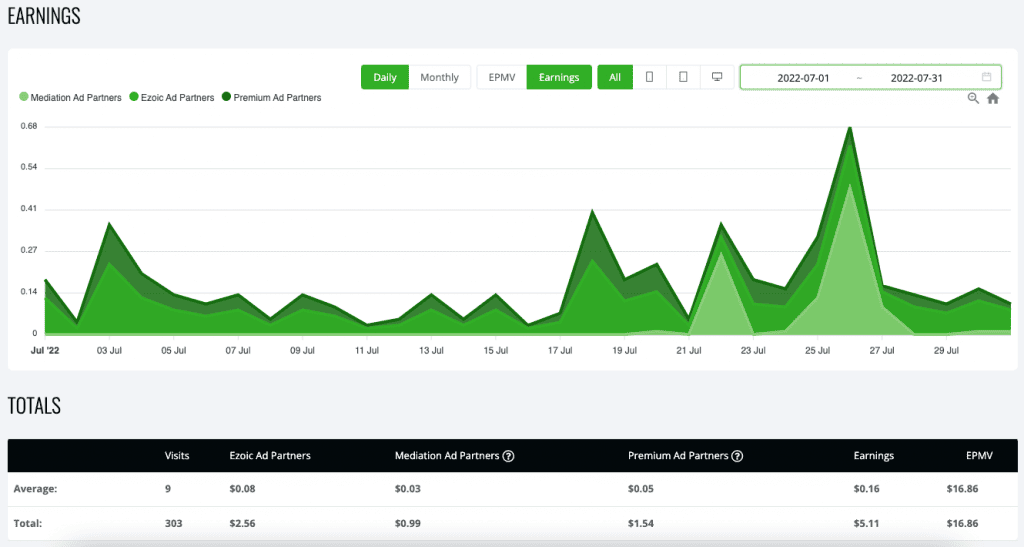
Month 8: First real traffic. First real income
Here in month 8, I’m letting the numbers speak for themself. The niche website is picking up in traffic and is starting to earn some real income.
I’m not going to retire anytime soon, but this is an exciting time for a website. I have been working on this site for some time, and now there is finally some actual feedback on if this was even a good idea, to begin with
nally, there are some results to report on, and all 62 articles are indexed.
| Month | Articles | Page Views | Earnings |
|---|---|---|---|
| January 2022 | 1 (100 % indexed) | 24 | 0 |
| February 2022 | 2 | 46 | 0 |
| March 2022 | 2 | 37 | 0 |
| April 2022 | 2 [+spam] | 247 | 0 |
| May 2022 | 62 (100 % indexed) | 155 | 0 |
| June 2022 | 64 | 284 | $ 0.31 |
| July 2022 | 64 | 311 | $ 5.10 |
| August 2022 | 64 | 555 | $ 7.37 |
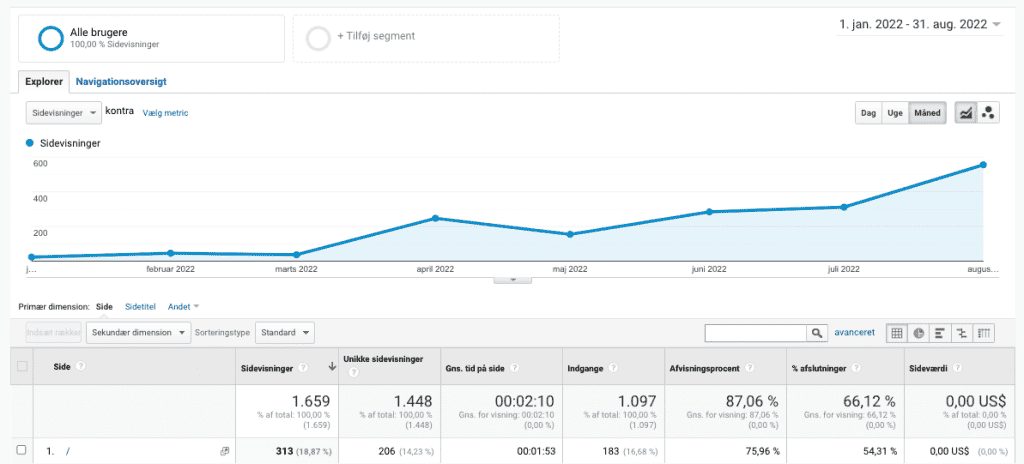
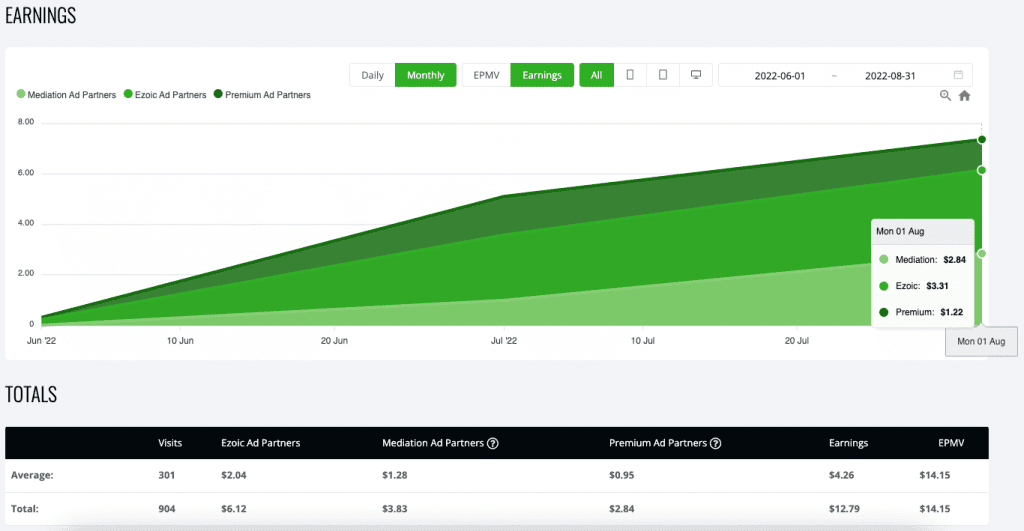
Month 9: Traffic is up. Earnings are down
Google updates and random fluctuations have sent the exposure down. The traffic is still up, but the earnings are down.
This month the site saw 626 pageviews and had $ 6.33 in earnings.
In this update video, I talk about my plans for updating the site to improve the numbers.
The discussion
I’m fairly certain you could see better numbers and more search traffic earlier if you don’t install spam on your site. Even though I watched it early it did nothing good for the site.
As for what the case study is concerned, this could still prove to be a good thing. If I can show you the basic techniques still work even though you make mistakes along the way.
I didn’t put any real amount of content on the site till May 1st. You could probably see quicker results if you put articles on as you write them.
In this case, though, I’d like to test if frontloading a site with content will show a steeper incline and faster way out of the anoxic period before a site gets any meaningful ranking positions (thanks to Jasper Pieterse that originally came up with the idea).
The Results
In the report from the end of September (month 9 for the project), I have 67 articles published and have everything indexed.
We are still waiting for solid proof of concept, though the numbers are looking promising.
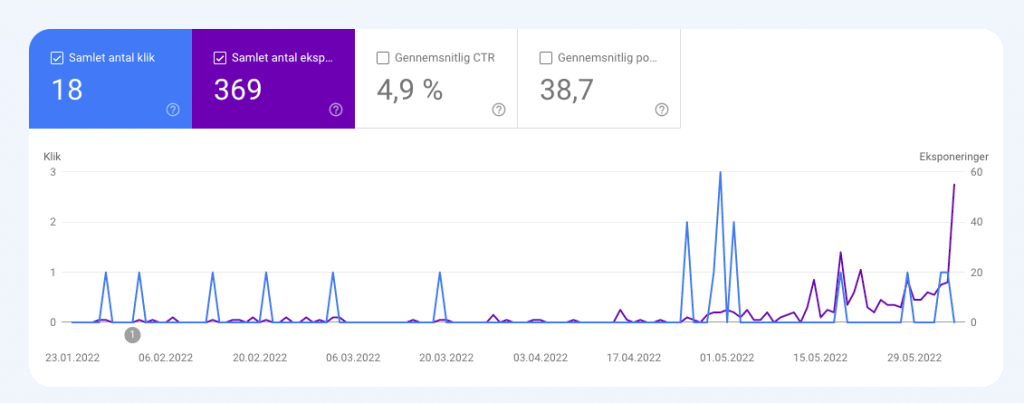
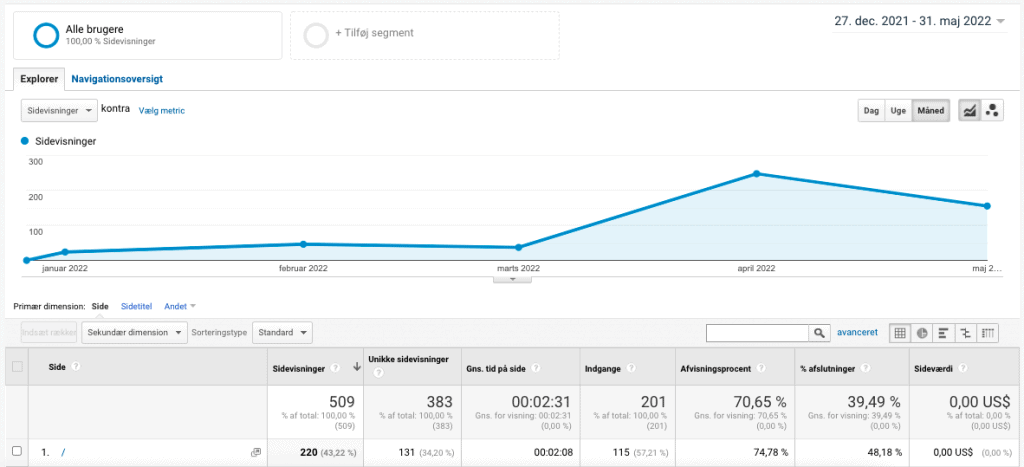
How Much Money Did I Make?
…pending
What I Learned From This Experiment
…pending
Final Thoughts
Even though I’ve been blogging for over a decade now, I still keep learning. Not just because search engines change, but also because there’s always a new strategy.
What this case study has done for me (so far) is to be more structured in my approach to testing and iterating on processes. Having to write for you and post videos has forced me to be more thorough and mindful of the test I’m actually running.
Outside of this case study, I’ve also made some (rather arbitrary) financial constraints for myself, pushing myself to see this website as a business, and not a hobby that could have just as well ended up as a forgotten failed project no one cared about.
Reporting and writing for you have helped me with this.
Thank You
First and foremost I want to thank Emilia Gardner. I highly recommend her community over on YouTube. If you’re interested in blogging and affiliate marketing and want an authentic look into the day-to-day work you should check out her YouTube channel.
Everyone else in that community has been super helpful and always has encouraging words to push through challenges. For that, I’m very thankful.
Finally, thanks to everyone who reads this! Knowing you’re here, and reading these experiments, makes the process so much more enjoyable for me.
I hope you learned something!
/Søren
